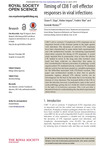Timing of CD8 T cell effector responses in viral infections
| dc.contributor.author | Stipp, Shaun R. | en_US |
| dc.contributor.author | Iniguez, Abdon | en_US |
| dc.contributor.author | Wan, Frederic | en_US |
| dc.date.accessioned | 2016-10-11T05:37:33Z | |
| dc.date.available | 2016-10-11T05:37:33Z | |
| dc.date.issued | 2016 | en_US |
| dc.identifier.other | HPU4160719 | en_US |
| dc.identifier.uri | https://lib.hpu.edu.vn/handle/123456789/23614 | en_US |
| dc.description.abstract | CD8 T cell or cytotoxic T lymphocyte (CTL) responses are an important branch of the immune system in the fight against viral infections. The dynamics of anti-viral CTL responses have been characterized in some detail, both experimentally and with mathematical models. An interesting experimental observation concerns the timing of CTL responses. A recent study reported that in pneumonia virus of mice the effector CTL tended to arrive in the lung only after maximal virus loads had been achieved, an observation that seems at first counterintuitive because prevention of pathology would require earlier CTL-mediated activity. | en_US |
| dc.format.extent | 12 p. | en_US |
| dc.format.mimetype | application/pdf | en_US |
| dc.language.iso | en | en_US |
| dc.subject | Biology | en_US |
| dc.subject | Theoretical biology | en_US |
| dc.subject | Virus dynamics | en_US |
| dc.subject | Mathematical models | en_US |
| dc.title | Timing of CD8 T cell effector responses in viral infections | en_US |
| dc.type | Article | en_US |
| dc.size | 1.13MB | en_US |
| dc.department | Education | en_US |
Files in this item
This item appears in the following Collection(s)
-
Education [806]

